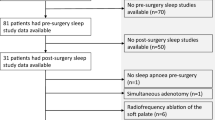Abstract
Objective
The objective of this study is to evaluate the efficacy of tonsillectomy in reduction of respiratory disturbance index (RDI) and other sleep study parameters in patients with obstructive sleep apnea (OSA).
Methods
This study involves 34 adults with OSA and Friedman grade 3 or 4 tonsils. All 34 patients were treated with tonsillectomy, as the only surgical treatment for OSA from 2007 to 2011. Pre- and postoperative polysomnography were performed in all these patients.
Results
Prior to tonsillectomy, 21 patients had severe, 9 had moderate, and 4 had mild OSA. Surgical response rate (defined as 50 % or more reduction in apnea–hypopnea index (AHI) and a postoperative AHI of less than 20) was 71.4 % among patients with severe OSA, 77.7 % among patients with moderate, and 75 % among patients with mild. Among all the 34 patients, there was a reduction of 24.6 (p = 0.000) in the RDI postoperatively. In our sub-analysis, we arbitrarily divided the patients into three groups: patients with RDI less than 30, patients with RDI between 30 and 60, and patients with RDI above 60. It showed that, in the group with RDI >60, an average reduction of RDI by 57.6 (p = 0.000) was achieved and was the greatest reduction in RDI.
Conclusions
Tonsillectomy alone may be considered as an effective first line surgical procedure in the treatment of OSA in selected patients. Patients with Friedman grade 3 or 4 tonsils may be considered for tonsillectomy as the initial surgical procedure, reserving other upper airway procedures at a later stage if necessary.
Similar content being viewed by others
References
Weaver TE, Kribbs NB, Pack AI, Kline LR, Churgh DK, Maislin G, Smith PL, Schwartz AR, Schubert NM, Gillen KA, Dinges DF (1997) Night-to-night variability in CPAP use over the first 3 months of treatment. Sleep 20:278–283
Weaver TE, Grunstein RR (2008) Adherence to continuous positive airway pressure therapy: the challenge to effective treatment. Proc Am Thorac Soc 5(2):173–178
Friberg D, Carlsson-Nordlander B, Larsson H, Svanborg E (1995) UPPP for habitual snoring: a 5-year follow-up with respiratory sleep recordings. Laryngoscope 105:519–522
Sher AE, Schechtman KB, Piccirillo JF (1996) The efficacy of surgical modifications of the upper airway in adults with obstructive sleep apnea syndrome. Sleep 19:156–177
Suen JS, Arnold JE, Brooks LJ (1995) Adenotonsillectomy for treatment of obstructive sleep apnoea in children. Arch Otolaryngol Head Neck Surg 121:523–530
Verse T, Kroker BA, Pirsing W, Brosch S (2000) Tonsillectomy as a treatment of obstructive sleep apnea in adults with tonsillar hypertrophy. Laryngoscope 110:1556–1559
Houghton DJ, Camilleri AE, Stone P (1997) Adult obstructive sleep apnoea syndrome and tonsillectomy. J Laryngol Otol 111:829–832
Orr WC, Martin RJ (1981) Obstructive sleep apnea associated with tonsillar hypertrophy in adults. Arch Intern Med 141:990–992
McGuirt WF Jr, Johnson JT, Sanders MH (1995) Previous tonsillectomy as prognostic indicator for success of uvulopalatopharyngoplasty. Laryngoscope 105(11):1253–1255
Hsu PP, Tan AK, Gan EC, Chan YH, Goh MM, Lu PK, Howe WL (2012) Computer-assisted quantitative upper airway analysis following modified uvulopalatal flap and lateral pharyngoplasty for obstructive sleep apnoea: a prospective case-controlled study. Clin Otolaryngol 37(3):188–196
Friedman M, Ibrahim H, Joseph NJ (2004) Staging of obstructive sleep apnea/hypopnea syndrome: a guide to appropriate treatment. Laryngoscope 114(3):454–459
Stow NW, Sale PJP, Lee D, Joffe D, Gallagher RM (2012) Simultaneous tonsillectomy and nasal surgery in adult obstructive sleep apnea: a pilot study. Otolaryngol Head Neck Surg 147(2):387–391
Nakata S, Noda A, Yanagi E, Suzuki K, Yamamoto H, Nakashima T (2006) Tonsil size and body mass index are important factors for efficacy of simple tonsillectomy in obstructive sleep apnoea syndrome. Clinc Otolaryngol 31:41–45
Verse T, Pirsig W (2007) Impact of impaired nasal breathing on sleep-disordered breathing. Sleep Breath 7(2):63–76
Maurer JT, Hirth K, Hormann K (1999) UPPP or LAUP: is this all surgeons should talk about? Sleep Breath 3(2):57–60
Research unit
Department of Otolaryngology, Changi General Hospital, Singapore
Conflict of interest
The authors declare that they have no conflict of interest.
Author information
Authors and Affiliations
Corresponding author
Rights and permissions
About this article
Cite this article
Tan, L.T.H., Tan, A.K.L., Hsu, P.P. et al. Effects of tonsillectomy on sleep study parameters in adult patients with obstructive sleep apnea—a prospective study. Sleep Breath 18, 265–268 (2014). https://doi.org/10.1007/s11325-013-0875-7
Received:
Revised:
Accepted:
Published:
Issue Date:
DOI: https://doi.org/10.1007/s11325-013-0875-7



